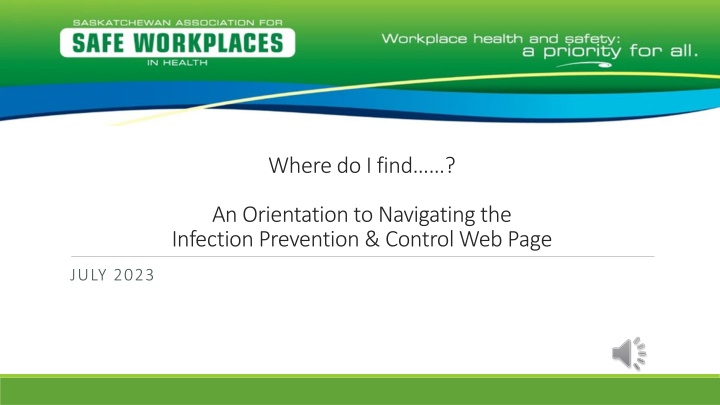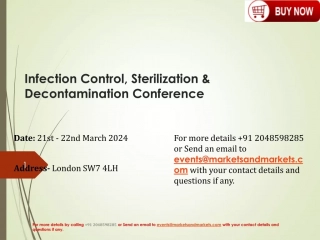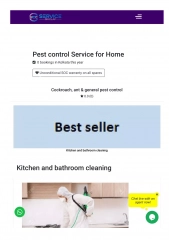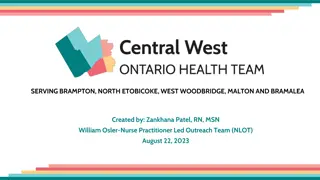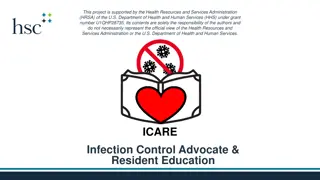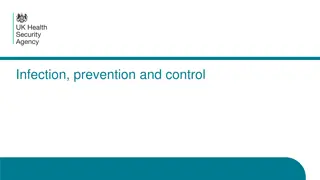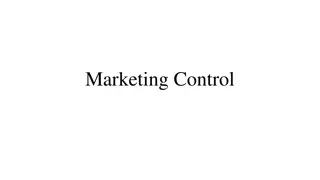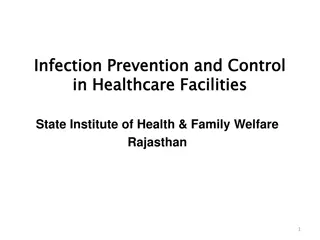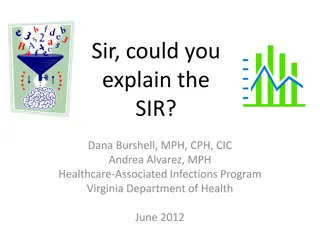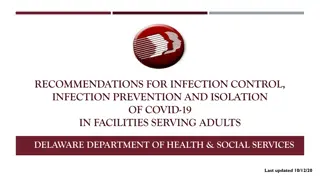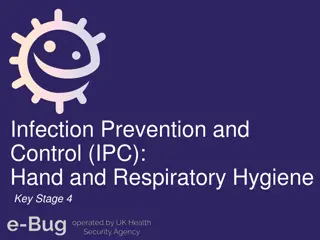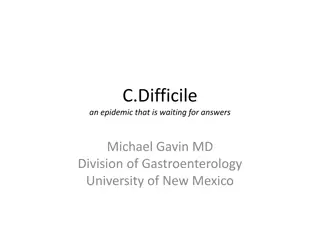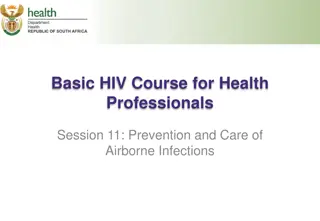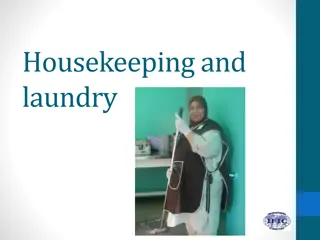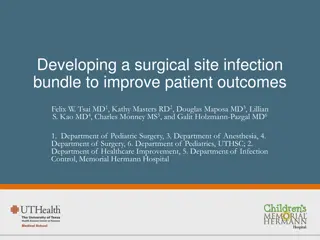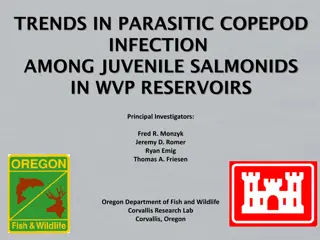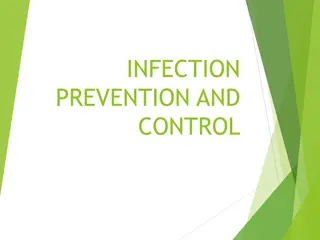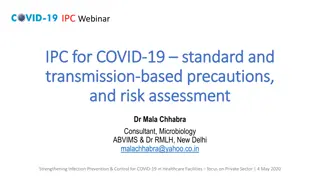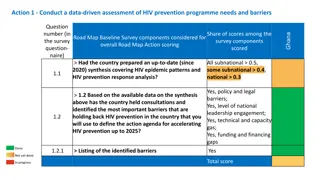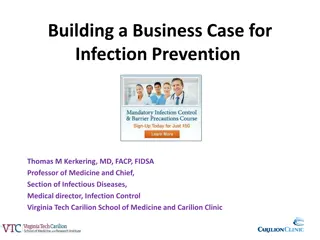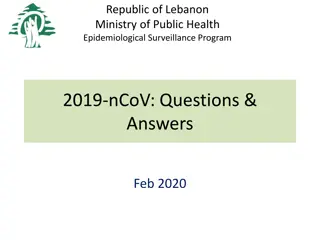Infection Prevention & Control Measures
Infection prevention and control measures are essential in healthcare settings and beyond to prevent the transmission of infectious diseases. This article covers the basics of infection prevention, routine practices, additional precautions, and resources for further education on the topic.
Download Presentation

Please find below an Image/Link to download the presentation.
The content on the website is provided AS IS for your information and personal use only. It may not be sold, licensed, or shared on other websites without obtaining consent from the author.If you encounter any issues during the download, it is possible that the publisher has removed the file from their server.
You are allowed to download the files provided on this website for personal or commercial use, subject to the condition that they are used lawfully. All files are the property of their respective owners.
The content on the website is provided AS IS for your information and personal use only. It may not be sold, licensed, or shared on other websites without obtaining consent from the author.
E N D
Presentation Transcript
Where do I find? An Orientation to Navigating the Infection Prevention & Control Web Page JULY 2023
What is Infection Prevention and Control? Infection control refers to evidence-based practices, that when consistently applied, will prevent or reduce the risk of transmission of infectious diseases to individuals Infection control draws from many sciences including microbiology, epidemiology, and environmental health Infection prevention and control is most commonly associated with healthcare settings; however, it is also a workplace safety concern (hand washing, cleanliness, and food preparation areas, etc., being common safety concerns) In its simplest context, infection control provides the controls for most biological hazards that are contagious
Routine Practices Routine Practices are the minimum standard of practice for preventing transmission of infectious diseases in all health care settings for all patients, including residents in group, residential and personal care homes. Included in Routine Practices are: Hand Hygiene Point of Care Risk Assessment Personal Protective Equipment (PPE) Resident Placement/Accommodation Respiratory Hygiene/Cough Etiquette Handling Resident Items & Equipment Linen & Dishes Environmental Cleaning Waste and Sharp Handling NOTE: In the United States, these are referred to as Standard Precautions. The old term, Universal Precautions, and blood and body fluid precautions were combined and replaced with Routine Practices.
Additional Precautions Although using Routine Practices with all residents, all the time, will satisfy most infection control issues, certain infections will require Additional Precautions. Additional Precautions are used when providing care to residents known or suspected to be infected with germs that spread easily in the environment. The type of Additional Precautions used are determined by the way germs could spread throughout the home or facility e.g., by contact, droplet or airborne.
Education An quick basic education course was needed for home operators and their staff. The SASWH team had already developed a COVID -19 education package for families. In addition, the IPAC staff had provided WebEx presentations on various infection control topics which were then recorded as a voice over Powerpoint presentation and uploaded to the site.
Exposure Control Plans There are three templates on this page: Required under OHS regulation 6-22 A generic template that can be used for common infections Format can be a template or group of templates A COVID-19 specific template A template for blood and body fluids
Documents on this page: SASWH Glossary Infection Prevention & Control SASWH Glove fact sheet SASWH Enviro Services Best Practices Cleaning Biological Spills Routine Practices SASWH Hand Hygiene - A guide to clean hands SASWH IPAC Practice Scenario These are the infection control practices that should be in place and being used on a daily and regular basis wherever care is being delivered to residents/clients. SASWH Point of Care Risk Assessment (PCRA) SASWH Risk of Transmission of Microorganisms Including Antibiotic Resistant Organisms SASWH Routine Practices SASWH Linen Laundry SASWH Enviro Services Best Practices General Cleaning Principles SASWH Worker Health Safety Clothing SASWH Worker Health Safety Fit to Work
Outbreak Preparedness and Management Outbreak Toolkit The toolkit is a document originally developed by staff in the Ministry of Health. It has been reviewed and reposted here. Appendix A Prepare for an Outbreak Appendix B - PPE The appendices are in the main document but are further separated on the page so items can be found quickly. There are a few additional documents that are not in the main file as these were developed after the original toolkit. Appendix C Additional Precautions and Other Posters Appendix D Aerosol Generating Medical Procedures (AGMP) Appendix E Screening Tools and Visitor Log Appendix F Outbreak Checklist and Cleaning Protocols
Information Sheets Gastro-Intestinal Illness The information sheets found in this section are intended to provide additional information about common infections. Influenza for General Public Influenza for Health Care Professionals The sheets can be used as an education tool with staff, clients, or families. Norovirus
Posters include: Germ Smart Hand Hygiene Sanitize Adult Germ Smart Hand Hygiene Wash Adult SASWH Doffing PPE Equipment Poster May 2021 Posters SASWH Donning PPE Equipment Poster May 2021 COVID-19 Aerosolize Settle Time Although some of these posters can be found in other sections, it was decided to dedicate space where this information could be found quickly. CV -19 Symptoms Poster Feb. 2021 CV-19 Break Room Requirements Physical Distancing in Effect Protect Yourself and Others Stop the Spread of Viruses Frontline Worker Guide Family Presence Levels At a Glance
Additional Information The following documents are on this page: These documents are written and maintained by other agencies but are important resources that support the development and maintenance of the various documents on the IPAC page. For example, if someone questions why a certain practice is carried out, that answer should be within one of the documents. Additional Precautions for ARO residents Best Practices for Environmental Cleaning in All Healthcare Settings 2018 Routine Practices & Additional Precautions 2017 Health Standards Organization (HSO) Outbreak Guidance LTC - SHA
IPAC Resources and Websites Want more information? Here are some reputable sites we used: Saskatchewan Health Authority Home | SaskHealthAuthority Government of Saskatchewan COVID-19 | Emerging Public Health Issues | Government of Saskatchewan SK Ministry of Health (Communicable Disease Manual) Manuals Communicable Disease Control Manual (ehealthsask.ca) World Health Organization https://www.who.int/ Center for Disease Control https://www.cdc.gov/ Public Health Agency of Canada https://www.canada.ca/en/public-health.html Public Health Ontario https://www.publichealthontario.ca/ IPAC Canada https://ipac-canada.org/ Alberta Health Services https://albertahealthservices.ca/ipc/ipc.aspx
